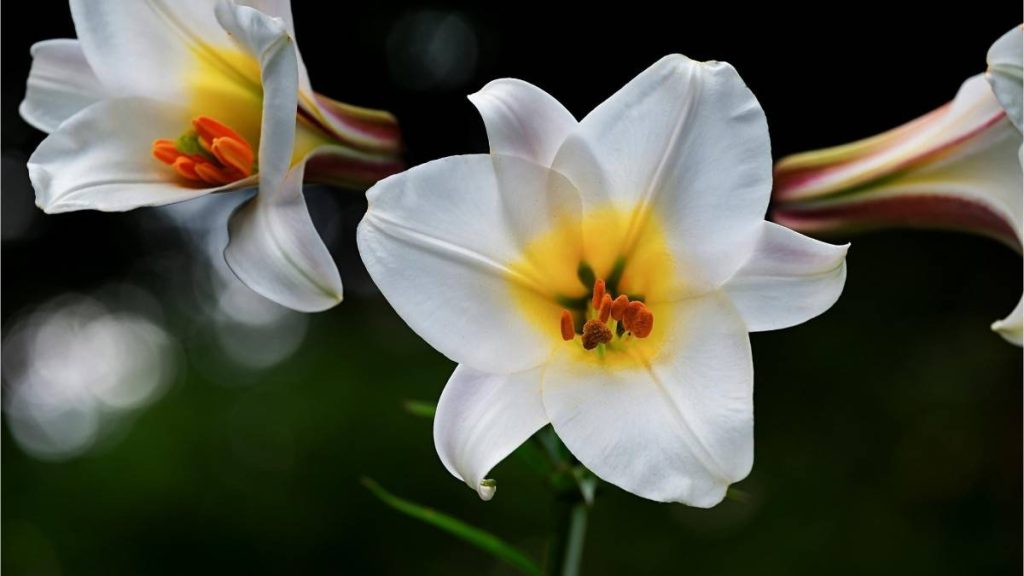When I first saw a Golden Stargazer in full bloom, its striking appearance left me speechless. That moment sparked a deep love for lily flowers, a fascination that has only grown over the years. These beautiful species are not just admired for their aesthetic and elegant qualities they carry a treasure trove of meanings, symbolism, and stories. The flowers of the Lilium genus, including hybrid varieties like Asiatic, Sorbonne, and Form osanum, have long captivated people across cultures. With their unique colors, shapes, and fragrance, lilies are a symbol of purity, innocence, ambition, and more. They are adored by gardeners, decorators, and brides-to-be, not just for their sweetness and subtleness, but for the deep emotions and memories they awaken.
The scent of fresh lilies on our kitchen table always brings back memories of my mother. She filled our home with their bright petals and clean, citrus-like fragrance a gentle spring breeze of nostalgia. Childhood photos show my fascination with their structure: petals and sepals framing the stigma, anthers unfurling to release pollen. One image captures the style and ovary; another, the forming seed pod.
From a botanical lens, lilies are marvels of precision three sepals, three petals, six filaments, and a single lobed stigma, as detailed in David Pilling’s annotated photographs. Their intricate design mirrors the quiet complexity of the memories they hold. Each time a lily opens, its anthers rotate from parallel to right angles, effectively increasing the chance that visiting insects get coated with pollen. It’s this blend of beauty and biology that keeps lilies symbolically versatile. They’re not just constructed to attract they carry deep, aesthetic value, meanings that stretch from ancient myths to contemporary celebrations. As Ralph Waldo Emerson once said, ‘Behold how we thrive in simplicity and purity.’ That’s what lilies give us: a moment to pause, reflect, and feel connected through experiences, emotions, and even across global cultures. Their astonishing beauty, their multitude of forms, and their role in our life stories make lilies unforgettable.
What do lily flowers symbolize across different cultures?
Lily flowers symbolize a range of meanings depending on the culture, purity and innocence in Christianity, renewal and motherhood in ancient Greek mythology, and even prosperity and good luck in Eastern traditions. Each color also holds a specific meaning, making lilies one of the most symbolically rich flowers in the world.

The Allure of Lily Flowers
There’s something undeniably charming about lily flowers their elegant form, rich colors, and lasting fragrance seem to whisper stories far beyond the surface. Lilies have always drawn me in not just for their beauty, but for their silent meanings. Every time I give or receive one, we exchange secrets. Their petals curl in a way that suggests both strength and softness, a duality that mirrors the essence of their symbolic power. After years of studying floral symbolism and growing flowers in my garden, I understand that lilies aren’t just visually stunning they carry centuries of emotion, history, and hidden meaning.
Lily Flowers and Their Unspoken Language
While roses might be the default language of love, lilies speak in quieter tones yet their message is just as profound. In Victorian times, flowers were used as coded messages when words were too dangerous or improper. Lily flowers, in particular, became symbols of purity, renewal and deep transformation. The white lily, for example, often represents innocence and rebirth, which is why it appears so often at both weddings and funerals two events marking major transitions in life.
In Eastern cultures, lilies hold even deeper layers of symbolism. In Chinese traditions, they are often gifted to women during significant life events, believed to bring a century of harmonious union in marriage. I remember attending a traditional ceremony where a family handed a bouquet of lilies to their daughter before her wedding. It wasn’t just a gesture it was a blessing spoken through petals.
The Dual Nature of Beauty and Meaning
What truly sets lily flowers apart is the way their beauty isn’t just skin deep. Their physical elegance complements their symbolic weight in a rare harmony. The subtle curve of a lily’s stem and the way it cradles its bloom create a shape that’s both strong and graceful. This visual poise is mirrored in what they stand for: womanliness, passion, and often, spirituality.
As a gardener, I’ve noticed how lilies demand care but not excessive attention almost like they know their value and require you to meet them halfway. This dynamic gives the act of growing them a meditative quality. When you watch a lily bloom, it’s hard not to think of how beauty and meaning can grow together, nourished by both effort and time.
The Emotional Impact of Gifting Lilies
There’s a profound emotional intelligence in choosing lilies as a gift. Each color tells its own story: white for purity, pink for admiration, orange for confidence, and red for passionate love. Unlike flowers that scream for attention, lilies feel like quiet confidants revealing their essence slowly, inviting deeper reflection.
I once received a bouquet of stargazer lilies from a friend after a personal loss. Their fragrance filled my space for days, and with it, a sense of calm that words couldn’t quite offer. In that moment, the secret meaning behind their beauty became personal. They were more than flowers they were solace, remembrance, and silent empathy.
A Timeless Symbol in Art and Culture
Lily flowers have consistently symbolized human expression from ancient mythology to modern art. Greek mythology tells how the lily sprang from Hera’s milk, representing divine motherhood. In religious art, especially within Christian traditions, the Madonna Lily frequently appears in depictions of the Virgin Mary, reinforcing themes of chastity and divine grace.
Throughout my travels, I’ve seen lilies carved into cathedral stonework, painted in Renaissance masterpieces, and woven into textiles in Southeast Asia. Their presence always seemed intentional, never just decorative. Artists and craftsmen across centuries understood what I now know as a truth lily flowers are visual metaphors, rooted in emotion, belief, and legacy.
Lilies in Mythology & History
It’s impossible to truly appreciate the beauty of lily flowers without stepping into the myths and stories that shaped their meaning over time. What fascinates me the most is how a single flower has managed to implant itself into the collective consciousness of so many cultures, across continents and centuries. The symbolism of lilies is not some recent interpretation it’s been carefully layered through mythology and historical tradition. The more I learned, the more I began to see lilies not just as flowers, but as living relics of ancient belief systems. They’re one of nature’s rare messengers, blooming with echoes from the past.
Divine Origins and Ancient Legends
In Greek mythology, the lily flower is said to have originated from the goddess Hera. As the legend goes, drops of her milk fell to Earth, and from them, the first lilies blossomed. This birth story gave the flower an association with divine femininity and motherhood. But there’s an intriguing contrast here: the same flower that symbolized maternal purity also became linked with seduction and power. Aphrodite, the goddess of love, is said to have grown jealous of the lily’s beauty. That duality innocence and allure has followed the flower into every cultural chapter since.
When I first read that myth, it struck a chord. It made sense that something so visually delicate could also hold the weight of powerful stories. I began to see lilies in a new light not as ornamental blooms, but as mythological artifacts.
Emblems of Power, Purity, and Ritual
Ancient Egyptians linked lilies to the afterlife. They especially revered blue water lilies, frequently depicting them in tomb paintings and burial goods. These flowers were more than mere decorations they symbolized resurrection, renewal, and the soul’s rebirth. As someone who’s spent time exploring ancient botanical texts, I found it incredible how consistently lilies appeared in funeral rites across different civilizations. Even in Roman culture, lilies were scattered at funerals and used in religious offerings.
In medieval Europe, lilies rose to prominence in Christian iconography. The Madonna Lily, with its striking white petals and golden stamens, became an emblem of the Virgin Mary. Churches used it to represent purity, chastity, and divine light. I’ve walked through old cathedrals where the only color breaking the stone’s gray silence was a stained-glass window of Mary holding a lily quiet but unforgettable.
Lilies as Historical Status Symbols
Beyond myth and ritual, lilies also served as markers of status and prestige. In France, the Fleur-de-Lis literally “flower of the lily” became the royal insignia of kings, symbolizing power, sovereignty, and divine right. Though stylized, it was unmistakably inspired by the shape of a blooming lily. Wearing or displaying a lily wasn’t just about beauty it was about belonging to a higher order, whether spiritual or societal.
When I visited the old French quarter of New Orleans, I remember spotting the fleur-de-lis embedded in gates, tiles, and architecture. It amazed me how a symbol rooted in centuries-old royalty had found its way into modern civic pride. The lily had traveled through time, not just surviving history, but helping shape it.
The Timeless Thread in Cultural Memory
What truly sets lily flowers apart in mythology and history is their adaptability. They’ve been interpreted as divine, sensual, pure, noble each culture sculpting its own layer of meaning while preserving the core allure. I often think of lilies as the storytellers of the botanical world. They don’t just grow they remember.
Even now, in a fast-moving world, we still turn to lilies during life’s most poignant moments. We plant them in gardens with reverence, use them in ceremonies, and hold them in art as symbols of something greater. That, to me, is the secret meaning behind their beauty: they are more than flowers they are myth in bloom.
Fun Facts About Lilies
Behind their refined beauty and timeless symbolism, lily flowers hide a world of delightful surprises. Over the years, I’ve come to appreciate not just their elegance or meaning, but the quirky, fascinating facts that make them even more captivating. As someone who’s spent countless hours nurturing lilies in different climates and reading up on their cultural and botanical background, I can say without hesitation these flowers have secrets worth sharing. What makes them so compelling isn’t just their poetic charm, but also the unexpected truths tucked between their petals.
Not All “Lilies” Are True Lilies
This one surprised me early in my gardening journey. Many flowers we commonly call lilies like daylilies or water lilies aren’t true lilies at all. True lilies belong to the Lilium genus and grow from bulbs, not tubers or rhizomes. I learned this the hard way while trying to care for a “lily” that refused to behave like the others. Turns out, I was dealing with an impostor!
True lilies have six petal-like tepals and a tall, slender stalk. Once you know what to look for, it becomes easy to spot the real ones. There’s something oddly satisfying about knowing you’re growing an authentic Lilium, especially once you can distinguish it from its lookalike cousins.
Lilies Are Global Travelers
Though often associated with Europe and Asia, lily flowers are world travelers. Native species grow wild in North America, too. From the woodlands of the Pacific Northwest to the mountains of Japan, lilies have made their home on nearly every continent (except Antarctica). Each region adds its own twist to the story whether it’s the regal Lilium regale of China or the fiery Lilium philadelphicum from Canada.
One of the joys of my work has been swapping bulbs with gardeners from different countries. Each lily carries not just soil from its homeland, but also its cultural roots. A rare Turkish lily once stunned me with its delicate backward-curving petals and spicy fragrance – so different from familiar stargazers.
They’ve Been on the Earth a Long Time
Lilies are no modern bloom. Fossil records suggest that lily flowers have existed for over 60 million years. That kind of evolutionary staying power is rare in the plant kingdom. Knowing this, I sometimes find myself staring at a bloom in awe, thinking: this flower has outlasted empires.
There’s a quiet dignity in that fact. It helps explain why lilies appear so often in rituals and myths they’ve been with us since the beginning, bearing witness to human civilization’s rise and fall.
Every Color Tells a Different Story
Most people know that flowers convey meaning, but with lilies, color plays a major role in their symbolic language. White lilies are universally known for purity and peace. Pink lilies hint at admiration and prosperity. Orange lilies, vibrant and bold, carry a message of confidence and passion. And red lilies? They’re intense symbols of deep love, sometimes even obsession.
I often recommend different varieties depending on the emotional message someone wants to convey. I once helped a friend build a bouquet that subtly told a story from hope to desire just by shifting shades of lilies. It was like writing poetry in petals.
Lilies Are Both Beautiful and Dangerous
Here’s one fact that’s more sobering than sweet: lilies are highly toxic to cats. Even the pollen or water from a vase can cause acute kidney failure. As a cat owner myself, I’ve had to develop strict boundaries admiring my lilies outside, never bringing them indoors.
Despite this, lilies continue to be used in herbal traditions, though with great caution. Some cultures have historically used parts of the lily bulb in remedies and even cuisine, but it’s a practice that demands knowledge and respect. Their beauty may seem delicate, but there’s a sharp intelligence beneath the surface nature’s reminder to handle awe with care.
They Can Bloom More Than Once a Year
Contrary to the belief that lilies are single-season showstoppers, many varieties are capable of blooming more than once a year, especially with careful pruning and the right climate. In my own garden, Asiatic lilies have surprised me with a second bloom cycle after deadheading and giving them just enough rest and fertilizer.
Watching a lily bloom again unexpectedly feels like a small miracle. It’s a reminder that beauty can return, even when you think it’s gone for the season. It’s one of those tiny rewards that make the patience of gardening so worthwhile
Final Thoughts
Lily flowers are more than just strikingly beautiful, they are rich in symbolism and hidden meanings. Across different cultures and eras, lilies have stood for purity, renewal, love, and remembrance. From white lilies representing innocence to pink ones symbolizing admiration, each color and variety tells a unique emotional story. Their graceful form and delicate fragrance only enhance their role as a flower of depth and expression.
Embracing lilies in your life or gifting them to others goes beyond aesthetics, it’s a gesture filled with emotion, history, and intention. Whether placed in a bouquet, garden, or sacred space, lilies whisper the silent messages of the heart, reminding us of the beauty found in meaning and the grace in simplicity.
Frequently Asked Questions (FAQs)
I’ve answered endless questions about lilies their beauty and meaning fascinate everyone. Here are the most common FAQs I’ve gathered.
Are all lilies fragrant?
This is one of the most common questions, and surprisingly, the answer is no. While some lilies are famous for their intense, intoxicating fragrance like Oriental lilies (Stargazer and Casablanca being personal favorites) others, such as Asiatic lilies, are almost completely scentless. I remember growing a row of gorgeous Asiatic hybrids, expecting their perfume to fill the summer air. To my surprise, they were silent in scent but loud in color.
So if you’re sensitive to smells or live with someone who is, there’s still a lily for you. On the flip side, if you crave that rich floral aroma, go for varieties known for their scent.
How long do lily flowers last?
In a vase, freshly cut lily flowers can last between 7 to 14 days, depending on the variety and care. Removing pollen (those powdery anthers) not only prevents stains on fabric but also extends the bloom’s life. In the garden, lilies typically bloom for one to three weeks per stalk, but staggered planting of different types can give you lily flowers for months.
I always suggest planting a mix of early, mid-, and late-season lilies. That way, you’re never without a bloom during the summer. It’s a strategy that makes your garden feel like it’s in constant, graceful motion.
Are lilies easy to grow?
For the most part, yes especially true lilies. They’re hardy, resilient, and respond well to care. Plant them in well-drained soil with full or partial sun, and they’ll reward you with tall, elegant stems and striking flowers. One tip from my own gardening experience: make sure you plant the bulbs about 6 inches deep and mulch them lightly to protect from extreme temperature changes.
I’ve had the best success by watering consistently but not excessively lilies don’t like wet feet. Once they’re established, they’re among the most reliable bloomers you can grow.
Can I grow lilies in pots?
Absolutely. In fact, some of my most successful lily blooms have come from containers. Choose a large pot with good drainage and high-quality soil. Asiatic and dwarf varieties do particularly well in pots. Just be mindful of water and sunlight, as container-grown lilies dry out more quickly and need consistent exposure to light.
One summer, I placed a group of potted lilies around my patio, and not only did they thrive, but they also became the centerpiece of every evening gathering. Their blooms opened gradually, almost theatrically, drawing everyone’s attention and admiration.
What’s the difference between Asiatic, Oriental, and Trumpet lilies?
These are all true lilies, but each group has its own distinct traits:
- Asiatic lilies bloom early, come in vivid colors, and are usually unscented.
- Oriental lilies bloom later, are large and intensely fragrant.
- Trumpet lilies have long, tubular blooms and a rich scent, resembling a fusion of the first two.
Understanding these differences can help you plan a more diverse and vibrant garden. I like to think of them as characters in a novel each with their own voice, timing, and personality.
Are lilies toxic to pets?
Yes, and this cannot be stressed enough lilies are extremely toxic to cats. Even a small amount of pollen or vase water can cause fatal kidney failure. Dogs are less sensitive, but it’s still best to keep lilies out of reach of all pets. As someone who shares space with two curious cats, I’ve made a strict rule: lilies stay outside or in closed-off rooms.
The beauty of lily flowers is undeniable, but so is their danger to pets. It’s always better to admire them with caution and prioritize safety.
Why do lilies have such strong symbolism?
Because they’ve appeared in religious texts, royal emblems, and ancient myths for millennia. Their structure graceful, balanced, and bold lends itself to deep metaphor. From purity and renewal to passion and power, lilies have carried layered meanings across cultures and centuries. I often say: You don’t just see a lily you feel it.
That emotional resonance is why people return to them again and again. Whether grieving, celebrating, or expressing love, lilies say what words often can’t.
Can lilies be used for anything besides decoration?
Traditional Chinese medicine uses certain types of lily bulbs for their supposed healing properties, including calming effects and respiratory treatments. However, these uses come with risk and require expert knowledge. I personally don’t recommend experimenting with medicinal uses unless you’ve consulted a specialist.
While lilies are mostly celebrated for their aesthetic and symbolic value today, it’s fascinating to know they once held medicinal roles. It speaks to the trust humanity has long placed in this extraordinary flower
Conclusion
Lily flowers have always felt like more than just plants to me. They’re stories, emotions, and quiet truths wrapped in petals beautiful on the outside, but rich with layered meaning just beneath the surface. Through mythology, history, personal experience, and even a few fun facts, what becomes clear is that the allure of lily flowers isn’t just about how they look. It’s about how they speak softly, symbolically, and with remarkable depth.
I’ve walked through gardens where lilies stood tall like sentinels, been comforted by their presence during moments of loss, and watched them bloom again after long winters, reminding me of resilience. Whether rooted in ancient myth, immortalized in royal emblems, or simply blooming quietly in a corner of your backyard, lilies carry a message that transcends time.
What I’ve learned through years of growing, gifting, and studying lilies is this: their beauty is just the beginning. The real magic is in their meaning silent, powerful, and profoundly human



